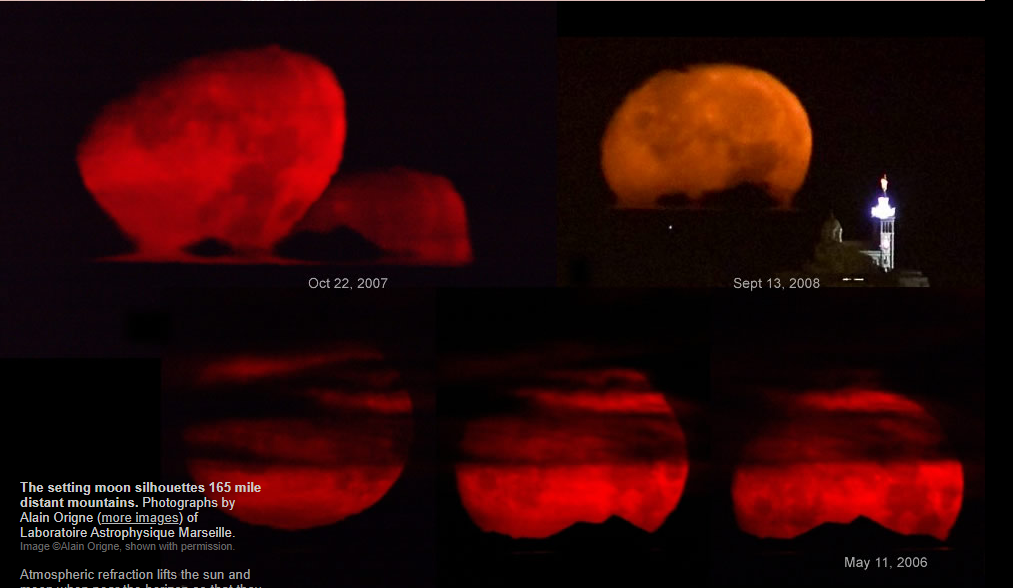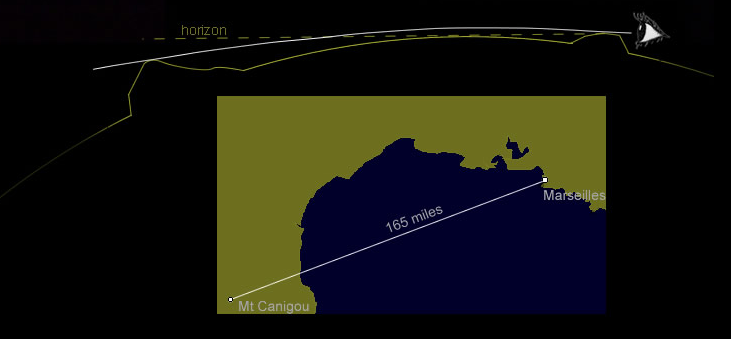Moon lights distant mountains
Moon Illuminating Distant Mountains: A Spectacular Phenomenon
Have you ever witnessed the breathtaking sight of the moon casting its ethereal glow upon distant mountains? This captivating atmospheric optics phenomenon, known as moonlight illumination, has fascinated observers for centuries. In this article, we will delve into the intricacies of this enchanting event and explore the science behind its occurrence.
The Magic of Moonlight on Distant Mountains
When the moon hangs low on the horizon, it has a remarkable ability to illuminate far-off mountain ranges, creating a mesmerizing spectacle. Photographs captured by Alain Origne of Laboratoire Astrophysique Marseille beautifully depict this phenomenon. The silhouettes of mountains located a staggering 165 miles away are outlined against the moonlit sky, evoking a sense of awe and wonder.
Atmospheric Refraction: Unveiling Hidden Beauty
The key to understanding the moonlight illumination lies in the concept of atmospheric refraction. This optical phenomenon is responsible for lifting the sun and moon slightly above the horizon, allowing them to remain visible even after they have technically set. As sunlight or moonlight passes through Earth's atmosphere, it undergoes a bending effect due to the variation in air pressure and density with altitude.
Unveiling Hidden Beauty through Refraction
The same principle of refraction that enables us to witness the setting sun or moon also unveils hidden beauty in the form of distant mountains. When these mountains are positioned behind the observer and are backlit by the sun or moon, their presence becomes apparent due to the bending of light rays. Alain Origne's photographs provide a striking example of this phenomenon, as Mt Canigou in the Pyrenees emerges from across the Mediterranean, 165 miles away from Marseilles, France.
Understanding Atmospheric Refraction
To comprehend how atmospheric refraction makes long-distance sightings possible, it is crucial to grasp the underlying mechanism. As sunlight or moonlight traverses Earth's atmosphere, it encounters varying densities of air. These different density layers act as a vast curved lens, causing the slanting rays of the sun or moon to bend downwards as they transition from regions of lower to higher density. Consequently, the paths of these rays exhibit a curving trajectory around the Earth.
Alain Origne: A Pioneer in Long-Distance Sightings
Alain Origne, renowned for his expertise in atmospheric optics, has dedicated extensive research to the study of moonlight illumination and its predictability. His work has shed light on the occurrence of this phenomenon and allowed him to forecast when and where it is likely to happen. Origne's passion for unraveling the mysteries of long-distance sightings extends beyond his own experiences. He eagerly invites individuals from around the world to share their similar encounters, fostering a global understanding of this captivating spectacle.
Joining Forces to Explore Moonlight Illumination
The magic of moonlight illumination is not limited to a specific region or time. It is a phenomenon that can be witnessed across the globe under the right conditions. By collaborating and sharing our observations, we can enhance our understanding of this extraordinary event. Whether you have marveled at distant mountains bathed in moonlight or have knowledge of similar occurrences, your contribution is invaluable in unraveling the secrets behind this optical marvel.
In conclusion, moonlight illumination casting its gentle glow upon distant mountains is an awe-inspiring atmospheric optics phenomenon. Atmospheric refraction plays a pivotal role in allowing us to witness this ethereal event, lifting the sun and moon above the horizon and revealing hidden beauty. Alain Origne's research and passion for long-distance sightings have contributed significantly to our understanding of this captivating spectacle. By coming together and sharing our experiences, we can further explore the mysteries behind moonlight illumination and continue to be enchanted by its breathtaking beauty.

The setting moon silhouettes 165 mile distant mountains. Photographs by Alain Origne (more images) of Laboratoire Astrophysique Marseille. Image ©Alain Origne, shown with permission.

Atmospheric refraction lifts the sun and moon when near the horizon so that they still appear after they have actually set.
The same refraction makes over the horizon objects visible when back-lit by the sun or moon. Here, Mt Canigou in the Pyrenees is seen from near Marseilles, France 165 miles away across the Mediterranean.
The refraction occurs because air pressure and density decrease with height. The different density layers act somewhat like a huge curved lens. The Sun or Moon's slanting rays are refracted downwards as they pass from lower to higher density. The net result is that ray paths tend to curve around the Earth.
Alain Origne, see previous OpticsPOD, has made an extensive study of the phenomenon and predicts when it will occur. He would like to hear of similar long distance sightings elsewhere in the world.
Note: this article has been automatically converted from the old site and may not appear as intended. You can find the original article here.
Reference Atmospheric Optics
If you use any of the definitions, information, or data presented on Atmospheric Optics, please copy the link or reference below to properly credit us as the reference source. Thank you!
-
<a href="https://atoptics.co.uk/blog/moon-lights-distant-mountains/">Moon lights distant mountains</a>
-
"Moon lights distant mountains". Atmospheric Optics. Accessed on November 23, 2024. https://atoptics.co.uk/blog/moon-lights-distant-mountains/.
-
"Moon lights distant mountains". Atmospheric Optics, https://atoptics.co.uk/blog/moon-lights-distant-mountains/. Accessed 23 November, 2024
-
Moon lights distant mountains. Atmospheric Optics. Retrieved from https://atoptics.co.uk/blog/moon-lights-distant-mountains/.